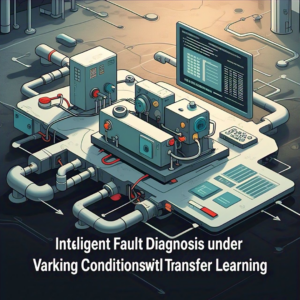Intelligent Fault Diagnosis under Varying Working Conditions with Transfer Learning

1. Introduction to Intelligent Fault Diagnosis in Smart Manufacturing
In the realm of smart manufacturing, particularly within the context of cloud computing and artificial intelligence, diagnosing faults efficiently is essential. As industries evolve towards more automated systems, challenges in fault diagnosis increase. Traditional methods often rely on extensive labeled datasets, which are hard to obtain in dynamic environments. Intelligent fault diagnosis, leveraging advanced techniques like transfer learning, becomes crucial here.
2. The Need for Intelligent Fault Diagnosis in Hybrid Cloud Computing
Fault diagnosis is critical for maintaining operational efficiency in industrial machinery. It involves identifying faults to prevent unexpected failures. Traditional methods, based on vibration analysis, face limitations in fluctuating environments. They often require extensive sensor setups and can be affected by noise, making them less reliable.
3. Challenges in Fault Diagnosis Under Varying Working Conditions
Data Scarcity: Many machine learning models require large amounts of labeled data to train effectively. In industrial settings, obtaining sufficient labeled data is challenging due to high costs and time involved.
Varying Working Conditions: Machinery operates under different conditions, affecting the performance of fault diagnosis models. Models trained on one set of conditions may not perform well when conditions change.
Complexity of Faults: Industrial machinery can experience multiple concurrent faults, complicating the diagnosis process. The interactions between different faults can obscure the signals indicating a problem.
Noise and Signal Processing: Signals obtained from machinery can be noisy, making it hard to extract meaningful features for diagnosis. Traditional techniques may not suffice in handling real-world data complexities.
4. Utilizing Artificial Intelligence for Intelligent Fault Diagnosis
Artificial intelligence and transfer learning provide promising solutions to fault diagnosis challenges. Transfer learning allows a model trained on one task to adapt to a different but related task. This approach is beneficial in environments with varying conditions, helping mitigate data scarcity and model performance issues.
5. Key Concepts in Transfer Learning
Parameter Transfer: This common form involves transferring parameters from a pre-trained model to a new model, leveraging knowledge from the source domain, even with limited data in the target domain.
Domain Adaptation: Adjusting the model to perform well on the target domain with different distributions. Techniques like fine-tuning and domain adversarial training can improve performance.
Feature Extraction: Features learned in the source domain can often be useful for the target domain, allowing for effective feature extraction without needing extensive labeled data.
6. Intelligent Fault Diagnosis Framework in Cloud Computing
The intelligent fault diagnosis framework proposed here utilizes transfer learning to enhance diagnosis of rotor-bearing systems under varying conditions. The framework consists of several key steps:
Data Collection: Thermal images of the rotor-bearing system are collected under different conditions to create a dataset with labeled and unlabeled samples.
Model Pre-training: A modified convolutional neural network (CNN) is pre-trained using a substantial amount of labeled data from the source domain, learning to extract relevant features from the images.
Transfer Learning Implementation: The pre-trained model’s weights and biases are transferred to a target model, which is fine-tuned using a smaller set of labeled samples from the target domain.
Performance Evaluation: The fine-tuned model’s performance is evaluated using a separate test set from the target domain, utilizing metrics like accuracy, precision, and recall to assess effectiveness in diagnosing faults.
7. Experimental Validation in Hybrid Cloud Environments
To validate the proposed method, experiments were conducted utilizing cloud computing principles with a GUNT PT500 rotating machinery setup. The system includes various components, such as a driven motor, rotor shaft, and thermal camera. Eight health conditions were simulated, and thermal images were collected at different speeds.
Data Preparation: Thermal images were converted to grayscale and divided into source and target domains, ensuring the source domain had sufficient labeled samples while the target domain had limited labeled samples.
Model Training: The modified CNN was trained on the source domain data, optimizing pooling strategy and activation functions to enhance feature extraction.
Fine-tuning: The model was fine-tuned using limited labeled samples from the target domain, adjusting parameters to improve performance under new conditions.
Results: The fine-tuned model achieved high accuracy in diagnosing faults, even with limited data from the target domain. This showcases the effectiveness of transfer learning in enhancing fault diagnosis capabilities.
8. Future Directions for Intelligent Manufacturing Systems
Future research should focus on refining transfer learning techniques, exploring unsupervised and semi-supervised learning, and integrating additional data sources like vibration and acoustic signals. Implementing these models in real-time within industrial settings holds critical importance, allowing for proactive maintenance and improved operational efficiency.
9. Conclusion on Disaster Recovery in Fault Diagnosis
The integration of disaster recovery strategies with transfer learning in intelligent fault diagnosis frameworks presents a promising solution to challenges posed by varying conditions. By leveraging pre-trained models and adapting them to new domains, achieving high diagnostic accuracy becomes feasible, even with limited labeled data. Additionally, Eigenvalue-Based Fault Diagnosis techniques can be incorporated to enhance feature extraction and anomaly detection, further improving the reliability of fault diagnosis. This approach not only strengthens fault identification but also enhances overall efficiency in smart manufacturing systems.
At Cloudastra Technologies, we specialize in software services tailored to meet your business needs. Visit us for more inquiries and explore how we can help enhance your operations with intelligent solutions.
Do you like to read more educational content? Read our blogs at Cloudastra Technologies or contact us for business enquiry at Cloudastra Contact Us.